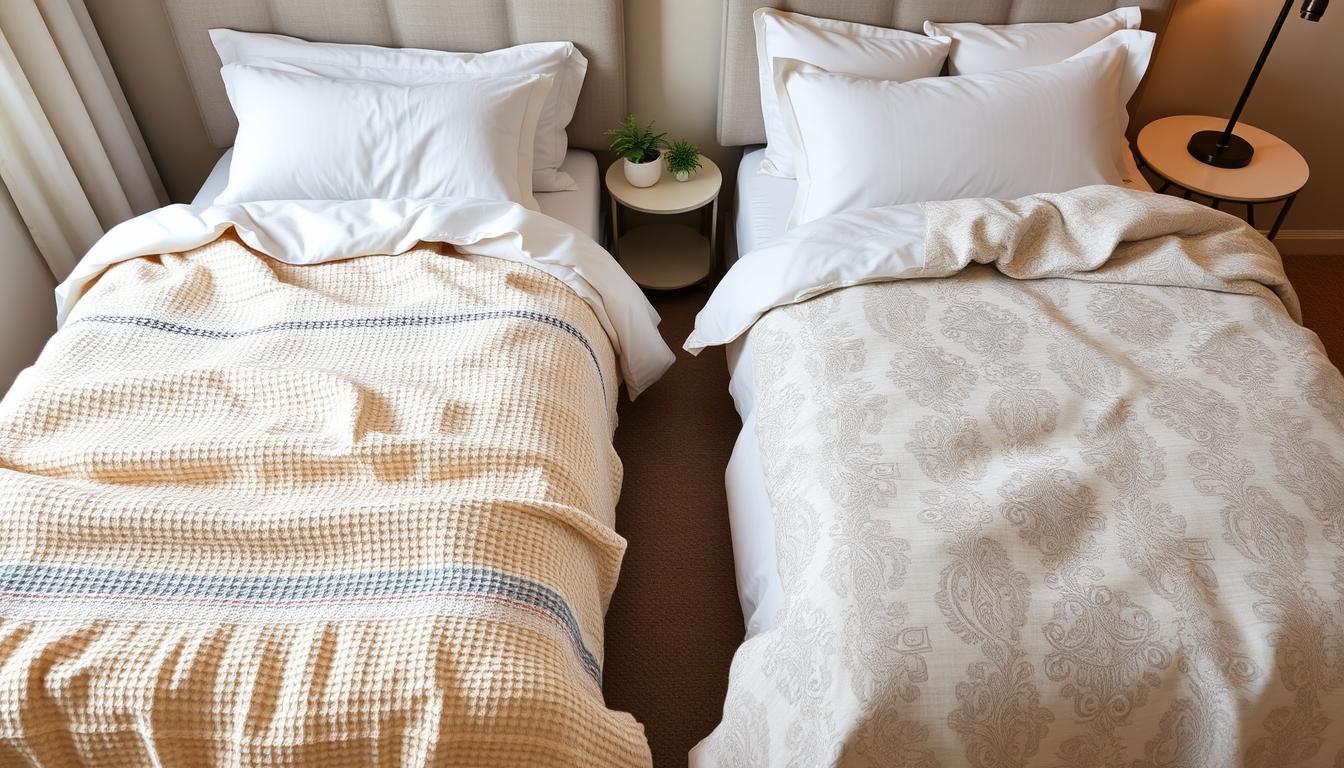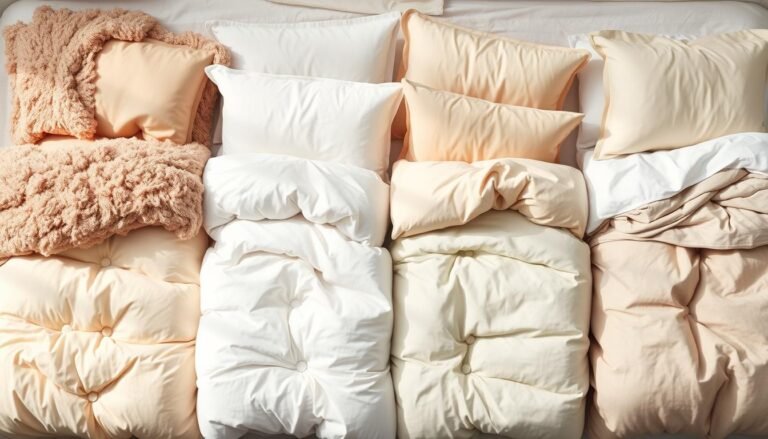Coverlet vs. Duvet Cover: What’s the Difference?
Choosing your bedding like a coverlet or duvet cover impacts your comfort and bedroom style. Your bed is key for relaxation and sleep. This guide explains the differences, helping you pick the best for your sleeping spot.
Coverlets are light, non-reversible bedspreads, mainly for looks. They work alone or add extra warmth. Made from quilted or woven fabric, coverlets layer easily. They come with matched pillowcases and sheets. But, coverlets require more cleaning and might wear out quicker.
Duvet covers cover duvet inserts, like a shield. They’re warm and easy to clean, with 60% of people preferring them for maintenance. These covers usually include matching shams for a unified bedroom style. Changing your bedding style is simpler with duvet covers.
Coverlets are for show, while duvet covers offer more warmth. Seventy-five percent choose duvets for their coziness. Take the Recover+ Comforter, for example. It’s great all year, making you warm or cool as needed. It also turns body heat into infrared energy for better sleep. Your choice between them depends on whether you want warmth, cleaning ease, or style.
For more bedding cover tips, visit this helpful site.
What is a Coverlet?
Coverlets are lightweight bedspreads, either quilted or woven, with a thin batting layer. They are not as heavy as comforters and lay flat on your bed. They bring elegance with their sophisticated looks. Unlike duvet covers, they don’t cover another layer for warmth but are beautiful and functional on their own.
Benefits of Coverlets
Coverlets are beneficial for many reasons. They are easy to use and add beauty to any room. Key advantages include:
- No Assembly Required: Coverlets are simple. They come ready to use, unlike duvet covers that need stuffing.
- Versatile Use: They work great on their own in warm months or as a decorative layer.
- Complimentary Accessories: Many come with matching shams for a unified look.
- Lightweight Design: Being light makes them easy to clean and care for, unlike heavy comforters.
Drawbacks of Coverlets
However, coverlets have some disadvantages:
- Frequent Washing: Lighter materials mean they may need more washes than heavier bedding.
- Wear and Tear: The thin fabric can easily wear out, so handle with care.
- Limited Warmth: They might not be warm enough alone in cold weather and may need extra layers.
Uses of Coverlets
Coverlets are versatile in many ways:
- As Standalone Bed Coverings: They are perfect alone in warmer months based on their weight.
- Layering: They can add warmth between a top sheet and a heavier blanket.
- Decorative Throws: Use them to add style to sofas or beds, and boost room decor.
- Room-to-Room Transition: Their light and versatile design lets them easily move around for different decor needs.
When comparing coverlets to quilts, their differences are clear. Quilts are larger and warmer, while coverlets are stylish, light choices for layering and decor. Understanding how coverlets differ from duvet covers also shows their unique role in bedroom comfort and design.
What is a Duvet Cover?
A duvet cover is both a protective and decorative layer for a duvet insert. This setup adds warmth and is easy to clean. Changing bedroom looks is easy without buying new bedding. So, what is a duvet cover? And how is it different from comforters? Let’s explore that.
Advantages of Duvet Covers
A major benefit of a duvet cover is its versatility. Changing your bed’s look is as simple as swapping the cover. This avoids the cost of new quilts or comforters.
Duvet covers also keep the insert free from stains and dirt. This is perfect for homes with kids or pets. They come in many styles and fabrics, like cotton or flannel. So, you can always find one that fits your room perfectly.
Challenges with Duvet Covers
However, duvet covers have their downsides. Putting the duvet back in after washing it can be hard. It’s tricky to align and secure the corners.
The filling may also move around, leading to uneven warmth. But understanding the difference between a duvet and a comforter helps. It lets you decide if a duvet cover works for you.
Types of Duvet Inserts
Choosing a duvet cover requires knowing about duvet inserts. Inserts can be filled with down feathers, synthetic fibers, or wool. Each type has its benefits.
Down is very warm while synthetics are good for allergies. Brands like Jennifer Adams Home have Lux Down Alternative Duvet Inserts. They’re stylish and functional for great bedding solutions.
What Are the Key Differences?
Understanding coverlets and duvet covers is key to making a good choice for your bedding. We’ll look at their design, construction, use, and how you can layer and store them.
Design and Construction
When looking at coverlet vs duvet cover, it’s important to compare their make. Coverlets often have one or two layers, being quilted or woven. They add a light, decorative touch. Duvet covers, however, wrap around a duvet insert. They are usually thicker, filled with down or synthetic fibers, bringing warmth and coziness.
There’s a variety of materials and styles for both coverlets and duvet covers. This means they can match different bedroom looks.
Intended Use
Coverlets are mainly for decoration or as light bed covers in warm seasons. They work well over another bedspread or by themselves for a bit of warmth.
On the other hand, duvet covers are about function. They cover duvets for added warmth and comfort. Perfect for cold weather, they also make duvets easy to wash and keep clean.
Layering and Storage
Coverlets are great for layering since they’re sleek and not bulky. They add style without taking up too much space.
Duvets and their covers might take up more room but are also easy to squash down for storing. This makes them great for changing out bedding with the seasons or when space is tight.
| Aspect | Coverlet | Duvet Cover |
|---|---|---|
| Design | One or two fabric layers, often quilted or woven | Enveloping a duvet insert with various fillings |
| Intended Use | Decorative layer, primary in warmer seasons | For significant warmth and comfort with a duvet |
| Layering | Sleek, no bulk, ideal for layering | Can be bulky, requires additional storage |
| Storage | Easy and compact | Lightweight and compressible |
Knowing these differences between coverlets and duvet covers will help you pick the right bedding for your home.
Is a Coverlet the Same as a Duvet Cover?
When comparing a coverlet vs duvet cover, it’s essential to know they serve different purposes. A coverlet is thin and adds a decorative touch to your room. It provides light coverage too.
In contrast, a duvet cover is a protective layer for a duvet insert. It adds softness and elegance. Unlike coverlets, duvet covers are designed to house a duvet insert for warmth.
Coverlets are versatile in function. They can be the main bedding or a throw over furniture. They are perfect for warm weather, unlike duvet covers which are ideal for the cold.
Duvet covers are practical because they’re easy to clean. They should be washed regularly. However, duvet inserts only need cleaning once every 2-3 months. Coverlets also look elegant and come in various fabrics.
The choice depends on personal needs. Duvet covers provide warmth and are easy to clean, making them practical. Coverlets are known for their elegant look and versatility, ideal for those who value aesthetics.
If you’re thinking about combining them, it’s possible. Using a coverlet on top of a duvet cover offers a visually appealing bed. This approach works well for different seasons.
- Coverlet Versatility: Can be used year-round, and excels in warmer weather.
- Cleaning Frequency: Duvet covers need frequent washing, while duvet inserts require less frequent cleaning.
- Styling Options: Both provide unique aesthetic choices, suitable for various preferences and seasons.
| Aspect | Coverlet | Duvet Cover |
|---|---|---|
| Primary Use | Light coverage, decoration | Encloses duvet insert for warmth |
| Construction | Pre-stitched, standalone | Washable shell, requires insert |
| Maintenance | Less frequent washing | Frequent washing of cover |
| Climate Suitability | Warmer weather | Colder weather |
It’s important to understand these differences when making your choice. Whether you prefer the versatile coverlet or the easy-to-clean duvet cover, each serves specific needs. For more on bedding maintenance, visit Cover Advice.
Choosing the Right Option for Your Bedding Needs
When picking between coverlet bedding and duvet cover bedding, it’s all about what you like. If a stylish and versatile bedspread is what you’re after, think about a coverlet. Coverlets are either quilted or woven. They are lightweight and perfect for decoration or for use in warm weather. They look elegant and fit perfectly on your bed.
If you’re looking for warmth and something easy to clean, go for a duvet cover instead. Duvet inserts keep you cozy with down feathers or alternatives. They come in all sizes and have washable covers. An article on duvets versus coverlets points out that duvets are great without a top sheet. This setup makes sleeping cleaner and simpler.
The climate and how warm or cool you like to sleep play a big role in this choice. A coverlet is perfect for warm places or if you like to stay cool at night. But in colder areas, a duvet’s warmth is more comforting. Choose what matches your style and makes you comfy and happy at night.
You can actually use both in your bedding setup. Mixing coverlets and duvets can make your bedroom look better and keep you comfy all year. Look at brands like Wooded River for custom bedding that fits your needs and style. They can boost both your bedroom’s look and your sleep quality.

Hey there, I’m Alex Hanson and I’m passionate about all things covers! Whether you’re looking for a car seat cover to protect your vehicle or an oven cover to keep your kitchen clean, I’m here to help. With years of experience in the industry, I have plenty of knowledge and insights to share with my readers. So, if you care about protecting your belongings and making them look their best, you’re encouraged to read my blog as I explore the perfect cover for every need.




